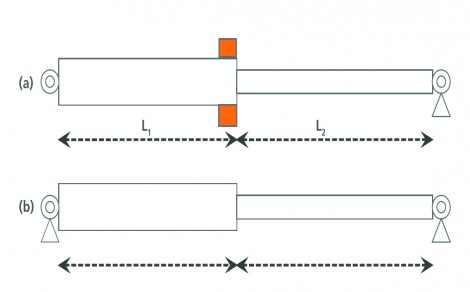- Home » Editorial » Hydraulics
How can optimisation of steel for piston rods improve the economics of hydraulic cylinders?

Rods in Cromax 180X will exhibit better resistance to buckling than corresponding rods based upon C45E steel. Hence, for a given effective length, a rod of Cromax 180X can be reduced in diameter compared with one in C45E, while still maintaining the same margin of safety against buckling. This is demonstrated quantitatively in Fig. 2 which depicts the diameter decrease which is attainable when rods of C45E-steel are swapped for ones in Cromax 180X. The downsizing is given as function of rod length for three different diameters, 45, 63 and 90 mm.
Naturally, any reduction in rod diameter results in a corresponding reduction in weight of the rod. The percentage weight reduction corresponding to the downsizing depicted in Fig. 2 is shown as a function of effective length in Fig. 3.
In addition to the benefits of weight reduction, there are economic advantages due to reduced material costs. As an illustration of the potential – a piston rod in steel C45E, 63 mm diameter and effective length 1000 mm can be replaced by a rod in Cromax 180X with diameter 55 mm giving a weight reduction of 5.8 kg or 24 %.
As an alternative, if a rod in steel C45E is replaced by one made of Cromax 180X with the same diameter, then it can transmit a greater load while keeping the same margin of safety against buckling. Obviously, a redesign will be required to enjoy the benefit of the increased load rating, involving increased diameters of the tube, piston, gland and so on, which may not always be realistic or feasible.
Improved fatigue life
The fatigue failure of piston rods occurs either at locations where a reduced section is combined with stress-concentration, at threads for example, or at welds. Fusion-welded piston rods are particularly susceptible to fatigue failure because the welds contain crack-like defects, are characterised by unfavourable tensile residual stresses and very often do not penetrate the entire cross-section of the rod. It is for this reason that piston rods, which are subjected to high alternating loads and which carry an elevated risk for fatigue failure, are usually friction welded. A properly-executed friction-welded joint is virtually defect-free and extends over the entire cross-section of the rod; it is therefore characterised by far greater fatigue strength than a corresponding fusion weld.
Tests have shown that the higher tensile strength of Cromax 180X (min. 750 MPa) offers a better fatigue performance than rods made of the conventional grade C45E with minimum tensile strength 590 MPa. Hence, the desired fatigue resistance can be achieved using a smaller diameter rod with positive benefits for weight and cost.
Good and consistent machinability
The machinability of Cromax 180X has been documented by testing in turning and threading. This shows that the steel can be processed efficiently by machining, compared with hard-chrome bars based upon steel C45E even though its strength and hardness are considerably higher.
-
PPMA 2025
23 September, 2025, 9:30 - 25 September, 2025, 16:00
NEC, Birmingham UK -
Advanced Engineering Show 2025
29 October, 2025, 9:00 - 30 October, 2025, 16:00
NEC, Birmingham UK










